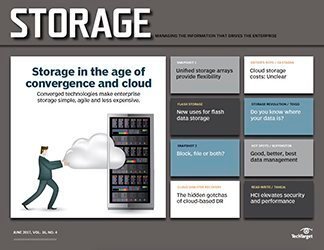PRO+ Premium Content/Storage
Access your Pro+ Content below.
Multiprotocol unified storage systems poised for growth

This article is part of the Storage issue of June 2017, Vol. 16, No. 4
Having to support two types of storage architectures to run applications that use storage at the block- or file-level is a thing of the past for enterprises that have given unified storage systems a try. Unified arrays can store data and applications used to run and manage file, block or both protocols on the same device. By giving you one system to manage, a multiprotocol array can simplify management and lower capital expenditures. However, the price for both types of storage may be too high if you only need block or file storage. A little more than 10% of enterprises today have this type of storage system installed in their data center, according to TechTarget research. That may not seem like much, but as we pointed out last month, the unified array market seems poised for an uptick over the next six months to a year. More than half of those who plan to buy unified arrays put their purchase timeframe at nine months to a year. Another 20% said they expect to buy one within the next six to nine months. Not surprisingly, the No....
Features in this issue
-
Multiprotocol unified storage systems poised for growth
With support for block, file or both types of data on the same device, unified storage architecture is a flexible storage option for the modern data center.
-
New use cases for flash data storage benefit enterprises
Adoption of protocols such as NVMe and memory bus-based flash DIMMs helps flash storage devices keep pace with the most demanding use cases.
Columns in this issue
-
Price of cloud storage may be fuzzy
Cloud storage services offer convenience and can cut IT spending, but not in every case. Make sure to do the math before you commit to putting your critical data in the cloud.
-
Three approaches to strategic data management: Good, better and best
It's time organizations take a more mature and sophisticated approach to data management techniques and make the most of the data they generate and consume.
